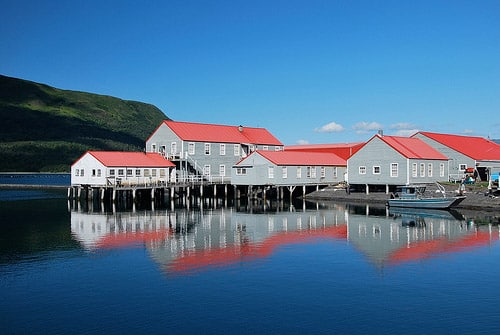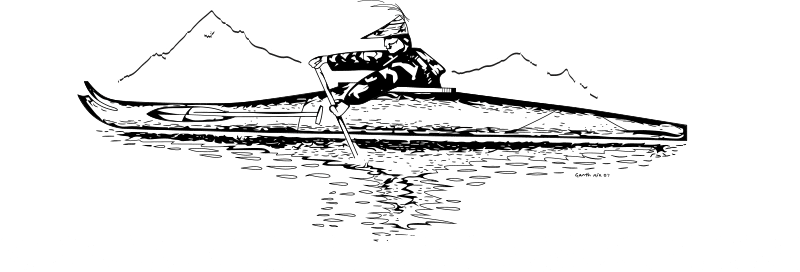FISHERIES – SWOT
STRENGTHS

- Wide diversity and sustainability of fishery species in the Kodiak Archipelago, providing nearly year-round fishery industry activity.
- Increasing maritime repair capabilities, industrial supplies, and infrastructure in the Kodiak region with a public-private partnership between the City of Kodiak and Highmark Marine for the management and operation of Kodiak Shipyard.
- Investment in and wide acceptance of science-based management of the fish industry.
- Community Quota Entities (CQE) Program participation:
- Five village communities participate in the CQE Program and all six villages are CQE eligible.
- Sun’aq Tribe’s “Kodiak Island WildSource” – custom fisheries and kelp processing capabilities and infrastructure.
WEAKNESSES
- The Greying of the Fleet: the aging population of fishery participants in harvesting and processing sectors with limited new generation participants entering the industry.
- Cost of entry is high, reducing the participation of the younger generation in the industry.
- Fishery value-added processing is limited in the Kodiak region with minimally processed catch shipped overseas for manufacturing into consumer products.
- Large trawl vessels have significant volumes of by-catch that are discarded, thus unavailable for small fleets to harvest.
- The high cost of energy reduces the attractiveness of processors/canneries in some village locations.
- Privatizing fisheries access has led to a decline in local ability for fishery participation.
- Some cannery jobs are perceived as not attractive for many village participants.
- Large processors in the Kodiak market have consolidated in recent years, which could translate into fewer jobs, reduced economic activity, and lower prices paid to fishery participants.
OPPORTUNITIES

- CQE program expansion to rural village communities: increase fishery quota that is owned locally and anchored in the village communities.
- Trade education and policy education for natural resource management – help educate the younger generation to increase their ability to participate in resource management and policy-making processes.
- Create fisheries policies that view fisheries as holistic ecosystems which include participation by the indigenous people and communities.
- Custom processing infrastructure facilities for smaller fishing businesses seeking to increase the value of their catch.
- The anticipated increase in biomass of sablefish due to climate change.
- Selling locally caught seafood from smaller boat fisheries through a catcher-seller permit direct to consumer dockside and at local grocery stores like the Kodiak Harvest Food Cooperative.
- City of Kodiak allows for the direct sales of fresh seafood to a consumer dockside from a fishing vessel.
- Fisheries enhancement in Old Harbor, working towards king crab and salmon enhancement in Three Saints Bay.
- Employment to village residents in a new processor/cannery proposed for Old Harbor
THREATS
- Foreign trade impacts, predominately from Russian seafood, flooding global markets and decreasing demand for Alaskan seafood.
- Includes increased technical capacity of foreign producers to compete with American-made value-added products (e.g. surimi production in Russia).
- Loss of access to and ability to participate in fisheries by local communities from third-party controlling interests.
- Fisheries Management is not currently supporting the long-term access and sustainability of marine resources for small coastal communities.
- Kodiak commercial salmon fisheries lost access to some areas and fishing time through a Board of Fish decision meant to reallocate stock to Chignik and northern Cook Inlet.
- Resource fluctuation and seasonality including changes in ocean chemistry, weather patterns, and marine production.
- Pacific cod decline, pink salmon disasters, and impacts due to climate change are examples of the delicate availability of targeted fisheries resources.
- The consolidation of processing companies; increased automation, decreasing workforce needs; and aging local workforce requiring importation from outside of Kodiak/Alaska/United States.
FISHERIES – NARRATIVE
Our Rural Communities, including Kodiak, are surrounded by a seemingly endless coastline and a wealth of marine resources. Inhabitants of this region have depended on the resources from the sea for many centuries for their existence. From living a subsistence lifestyle, hunting, and fishing from skin-covered kayaks, through forced labor during the Russian settlement hunting for fur, to the commercial fishing era in the early 1900s. The marine ecosystem has provided food, an economy, and a way of life.
The majority of the population around Kodiak Island, and all of our village communities, are settled alongside the sea and rely on the resources that come from it. Utilizing these resources is vital to the economic stability of the region. Managing the sustainability of these resources is vital to ensure that future generations continue to benefit from the potential economic stability.
There has been a steady decline in the fishing and maritime industry as a result of several critical and varied causes:
- The financial and social reduction in the importance of Wild Alaska Salmon;
- The devastating effects of the 1964 earthquake, which destroyed many of the fish processing plants around Kodiak Island that employed residents of the rural villages;
- The decrease in access stemming from the implementation of the limited entry program for salmon by the State of Alaska in the 1970s, and the Pacific Halibut and Sablefish Individual Fishing Quote (IFQ) catch share program in the 1990s;
- The Exxon Valdez Oil Spill.
All of these events have contributed to this drastic decline, impacting the economic and socio-economic state of the rural villages of the Alutiiq community in the Kodiak region.
The state of the fisheries industry in 2024 is precarious, with Russian seafood flooding the global markets, demand for Alaska seafood has slumped significantly. The detrimental impacts of the global market have created uncertain economic conditions which are expected to cause ripples throughout the Kodiak region. Examples include Trident Seafood’s divestment of assets throughout Alaska, including Kodiak, the announcement that OBI Seafoods will not purchase salmon at the Alitak Cannery and not process salmon at the Larsen Bay Cannery, and a recent increase in electricity prices provided by Kodiak Electric Association due to the forecast decrease in seafood processing in the City of Kodiak.
Community Quota Entities (CQEs) pose an opportunity for economic development in our village communities. The purpose of the CQEs is to create jobs and revenue for economically distressed communities. The problem is the challenge of purchasing the quotas at a price that allows the CQEs sufficient income to pay the debt service. However, the prices for quota shares have gone up to the point that this is not feasible. At current quota pricing, a down payment (either existing capital or a grant) of about 33% would be needed to cover the debt service. CQEs generally don’t have an initial asset base and have had limited success in securing down payments through other means.
There are active Community Quota Entities (CQEs) in Ouzinkie (about 17,000 pounds of halibut quote in Area 3A), Old Harbor (about 7,000 pounds in 3B and about 1,200 pounds in 3A) and Port Lions (quota data unavailable at writing). Local fishermen’s requests substantially exceed the available quota each year and each community can purchase up to 50,000 pounds of quota, which likely could be easily fished. (Note: asking about updated numbers and asking if this information should be provided publicly)
The fishery dependent, Native Village of Old Harbor, is in the midst of a long-range, multi-pronged economic development strategy that has the ultimate goal of returning the economic benefit of fisheries to the community; through creative funding, strategic partnerships, long-range planning, and a lot of hard work. Old Harbor has completed its airport runway expansion project, has received grant funding to build a run-of-river hydroelectric project, and is developing a salmon enhancement project in Three Saints Bay. All of these inter-related projects and efforts ultimately lead to the development of a frozen fish processing facility in Old Harbor. It is reported that there are cannery operators who are highly interested in developing a frozen fish processing facility in Old Harbor.
The infrastructure improvements provide the necessary access to transport the product to market, renewable electricity to produce the product, and the fish necessary to harvest for the product. The improvements are also in response to what potential private investors need to operate the plant efficiently.
The Sun’aq Tribe of Kodiak purchased the Ursin property in 2016, which is a long-ago abandoned cannery near downtown Kodiak. The tribe has expanded its Kodiak Wild Source processing capacity at this location and would like to build a restaurant, cultural center, and/or another complimentary business space.
During the March 2021 Kodiak Archipelago Rural Regional Leadership Forum, the following Issues, Goals, and Strategies related to the Fisheries economic cluster were developed.

